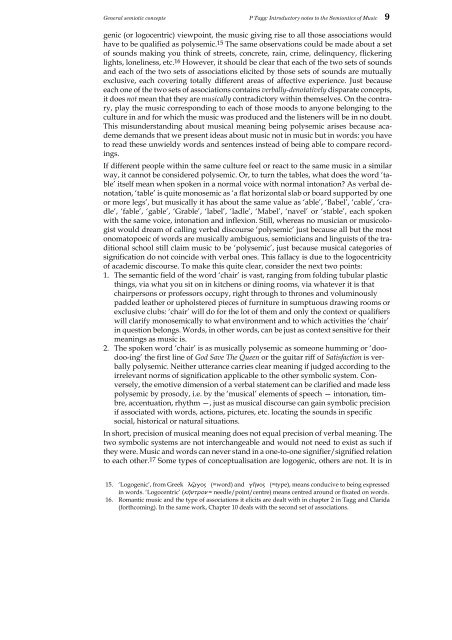Introductory notes to the Semiotics of Music - Philip Tagg's home page
Introductory notes to the Semiotics of Music - Philip Tagg's home page
Introductory notes to the Semiotics of Music - Philip Tagg's home page
You also want an ePaper? Increase the reach of your titles
YUMPU automatically turns print PDFs into web optimized ePapers that Google loves.
General semiotic concepts P Tagg: <strong>Introduc<strong>to</strong>ry</strong> <strong>notes</strong> <strong>to</strong> <strong>the</strong> Semiontics <strong>of</strong> <strong>Music</strong> 9<br />
genic (or logocentric) viewpoint, <strong>the</strong> music giving rise <strong>to</strong> all those associations would<br />
have <strong>to</strong> be qualified as polysemic. 15 The same observations could be made about a set<br />
<strong>of</strong> sounds making you think <strong>of</strong> streets, concrete, rain, crime, delinquency, flickering<br />
lights, loneliness, etc. 16 However, it should be clear that each <strong>of</strong> <strong>the</strong> two sets <strong>of</strong> sounds<br />
and each <strong>of</strong> <strong>the</strong> two sets <strong>of</strong> associations elicited by those sets <strong>of</strong> sounds are mutually<br />
exclusive, each covering <strong>to</strong>tally different areas <strong>of</strong> affective experience. Just because<br />
each one <strong>of</strong> <strong>the</strong> two sets <strong>of</strong> associations contains verbally-denotatively disparate concepts,<br />
it does not mean that <strong>the</strong>y are musically contradic<strong>to</strong>ry within <strong>the</strong>mselves. On <strong>the</strong> contrary,<br />
play <strong>the</strong> music corresponding <strong>to</strong> each <strong>of</strong> those moods <strong>to</strong> anyone belonging <strong>to</strong> <strong>the</strong><br />
culture in and for which <strong>the</strong> music was produced and <strong>the</strong> listeners will be in no doubt.<br />
This misunderstanding about musical meaning being polysemic arises because academe<br />
demands that we present ideas about music not in music but in words: you have<br />
<strong>to</strong> read <strong>the</strong>se unwieldy words and sentences instead <strong>of</strong> being able <strong>to</strong> compare recordings.<br />
If different people within <strong>the</strong> same culture feel or react <strong>to</strong> <strong>the</strong> same music in a similar<br />
way, it cannot be considered polysemic. Or, <strong>to</strong> turn <strong>the</strong> tables, what does <strong>the</strong> word ‘table’<br />
itself mean when spoken in a normal voice with normal in<strong>to</strong>nation? As verbal denotation,<br />
‘table’ is quite monosemic as ‘a flat horizontal slab or board supported by one<br />
or more legs’, but musically it has about <strong>the</strong> same value as ‘able’, ‘Babel’, ‘cable’, ‘cradle’,<br />
‘fable’, ‘gable’, ‘Grable’, ‘label’, ‘ladle’, ‘Mabel’, ‘navel’ or ‘stable’, each spoken<br />
with <strong>the</strong> same voice, in<strong>to</strong>nation and inflexion. Still, whereas no musician or musicologist<br />
would dream <strong>of</strong> calling verbal discourse ‘polysemic’ just because all but <strong>the</strong> most<br />
onoma<strong>to</strong>poeic <strong>of</strong> words are musically ambiguous, semioticians and linguists <strong>of</strong> <strong>the</strong> traditional<br />
school still claim music <strong>to</strong> be ‘polysemic’, just because musical categories <strong>of</strong><br />
signification do not coincide with verbal ones. This fallacy is due <strong>to</strong> <strong>the</strong> logocentricity<br />
<strong>of</strong> academic discourse. To make this quite clear, consider <strong>the</strong> next two points:<br />
1. The semantic field <strong>of</strong> <strong>the</strong> word ‘chair’ is vast, ranging from folding tubular plastic<br />
things, via what you sit on in kitchens or dining rooms, via whatever it is that<br />
chairpersons or pr<strong>of</strong>essors occupy, right through <strong>to</strong> thrones and voluminously<br />
padded lea<strong>the</strong>r or upholstered pieces <strong>of</strong> furniture in sumptuous drawing rooms or<br />
exclusive clubs: ‘chair’ will do for <strong>the</strong> lot <strong>of</strong> <strong>the</strong>m and only <strong>the</strong> context or qualifiers<br />
will clarify monosemically <strong>to</strong> what environment and <strong>to</strong> which activities <strong>the</strong> ‘chair’<br />
in question belongs. Words, in o<strong>the</strong>r words, can be just as context sensitive for <strong>the</strong>ir<br />
meanings as music is.<br />
2. The spoken word ‘chair’ is as musically polysemic as someone humming or ‘doodoo-ing’<br />
<strong>the</strong> first line <strong>of</strong> God Save The Queen or <strong>the</strong> guitar riff <strong>of</strong> Satisfaction is verbally<br />
polysemic. Nei<strong>the</strong>r utterance carries clear meaning if judged according <strong>to</strong> <strong>the</strong><br />
irrelevant norms <strong>of</strong> signification applicable <strong>to</strong> <strong>the</strong> o<strong>the</strong>r symbolic system. Conversely,<br />
<strong>the</strong> emotive dimension <strong>of</strong> a verbal statement can be clarified and made less<br />
polysemic by prosody, i.e. by <strong>the</strong> ‘musical’ elements <strong>of</strong> speech — in<strong>to</strong>nation, timbre,<br />
accentuation, rhythm —, just as musical discourse can gain symbolic precision<br />
if associated with words, actions, pictures, etc. locating <strong>the</strong> sounds in specific<br />
social, his<strong>to</strong>rical or natural situations.<br />
In short, precision <strong>of</strong> musical meaning does not equal precision <strong>of</strong> verbal meaning. The<br />
two symbolic systems are not interchangeable and would not need <strong>to</strong> exist as such if<br />
<strong>the</strong>y were. <strong>Music</strong> and words can never stand in a one-<strong>to</strong>-one signifier/signified relation<br />
<strong>to</strong> each o<strong>the</strong>r. 17 Some types <strong>of</strong> conceptualisation are logogenic, o<strong>the</strong>rs are not. It is in<br />
15. ‘Logogenic’, from Greek l“gow (=word) and g∞now (=type), means conducive <strong>to</strong> being expressed<br />
in words. ‘Logocentric’ (k∞ntron = needle/point/centre) means centred around or fixated on words.<br />
16. Romantic music and <strong>the</strong> type <strong>of</strong> associations it elicits are dealt with in chapter 2 in Tagg and Clarida<br />
(forthcoming). In <strong>the</strong> same work, Chapter 10 deals with <strong>the</strong> second set <strong>of</strong> associations.














